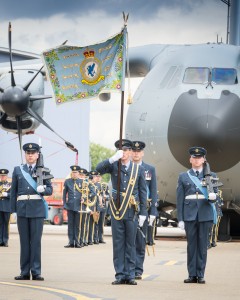2015-07-24 No. 70 Squadron (also known as No. LXX Squadron) of the Royal Air Force will be the first operational unit to use the new Airbus A400M Atlas.
According to an article published July 25, 2015 on the UK MoD website, the Squadron has also received a new standard.
Her Royal Highness, The Princess Royal, today attended the Re-formation Parade for LXX Squadron, Royal Air Force Brize Norton. Princess Anne, Honorary Air Commodore to Brize Norton was the Reviewing Officer for the parade and presented LXX Squadron with its new Standard.

Princess Anne was accompanied by Chief of The Air Staff, Air Chief Marshall Sir Andrew Pulford and Royal Air Force Brize Norton Station Commander, Group Captain Simon S Edwards, as she reviewed the Squadron. LXX Squadron, commanded by Wing Commander Simon Boyle, looked impressive as they paraded in front of one of the new A400M Atlas aircraft. The presentation of the new Standard is a very significant moment in the history of the Squadron. Princess Anne acknowledged the importance of the Standard and wished the Squadron a successful future.
Officer Commanding LXX Squadron, Wing Commander Simon Boyle, explained that the Standard: “was traditionally the rallying point, unique to the Squadron and a symbol of the trust that the monarch places in the Squadron. It includes the badge and the battle honours that have been bestowed upon the Squadron.”
LXX Squadron will be the first Squadron to operate the A400M Atlas in support of military tasks and humanitarian relief efforts across the world. The A400M Atlas will replace the existing fleet of Hercules which has been the tried and tested workhorse of the Royal Air Force’s transport fleet for decades.
The A400M Atlas is a new aircraft coming into service in the RAF. LXX Squadron, based at RAF Brize Norton, will be the first squadron to operate the aircraft in support of military tasks and humanitarian relief efforts across the world. The aircraft will replace the existing fleet of C-130 Hercules which have been the tried and trusted workhorse of the RAF’s air transport fleet for decades.
Manufactured by Airbus Defence & Space, A400M Atlas will represent major advances on its predecessor, capable of flying almost twice as fast, twice as far and carrying almost twice as much cargo. With a cargo capacity of 32 tonnes and a hold optimised for carriage of heavy vehicles, helicopters or cargo pallets, the aircraft is capable of supporting a wide range of operational scenarios. The UK is the third country to operate the aircraft, after France and Turkey and the £2.8 billion programme will see a total of 22 aircraft delivered to the RAF in the coming years.
http://www.raf.mod.uk/news/archive/lxx-sqn-standup-24072015
History of Number LXX Squadron
Formed at South Farnborough on 22 April 1916, Number LXX Squadron was the first Royal Flying Corps Squadron to fly the Sopwith 1½ Strutter. The unit transferred to Fienvillers in France one Flight at a time such was the gravity of the situation between May and August 1916 to take up fighter patrols. As the Germans perfected their tactics, losses on the Squadron rose, and a year later the Squadron converted to the more capable Sopwith Camels.
After the Armistice, the unit remained in Germany until February 1919 when it returned to the UK, disbanding briefly during January 1920 only to reform nine days later at Heliopolis, Egypt by renumbering No 58 Squadron equipped with Vickers Vimy heavy bombers. Within three years, No LXX Squadron had moved to Iraq and re-equipped with Vickers Vernon bombers/transports which were flown on the Cairo-Baghdad air mail run until 1927.
During this time, the Squadron also took part in operations against rebel tribesmen and insurgents on the Turkish frontier and received Vickers Victorias shortly before the famous evacuation of Kabul in 1928. Vickers Valentias arrived in 1935, and these lumbering aircraft spent the first year of World War II on transport duties around the Middle East until Vickers Wellington bombers replaced them in late 1940.

Successive versions of the Wellington were used during the North African and Italian campaigns and it wasn’t until February 1945 that Consolidated B-24 Liberators replaced them and remained with the Squadron when it returned to the Middle East at the end of the year and disbanded in April 1947.
In May 1948, No 215 Squadron based at Kabrit, Egypt, was renumbered No LXX Squadron, and the unit resumed transport duties around the region with Douglas C-47 Dakotas. Shortly before re-equipping with Handley Page Hastings in late 1955, the Squadron and its Vickers Valletas transferred to Cyprus, subsequently taking part in the Suez campaign in 1957. Following a short-lived period with Armstrong Witworth Argosys, No LXX Squadron began converting to the C-130K Hercules and finally returned to the UK, joining the Lyneham Transport Wing in 1975 after 55 years overseas.
In September 2010 No LXX Squadron stood-down once more to await the arrival of the Royal Air Force’s new Airbus A400M ‘Atlas’ aircraft; the Squadron Colour was lodged at Royal Air Force College Cranwell and marked the end of the Squadron’s outstanding period of C-130K Hercules operations around the world.
Number LXX Squadron is the first operational Airbus A400M Atlas Squadron. The Squadron stood up in an administrative and engineering support capacity on 1 October 2014, allowing sufficient time for it to be configured and manned appropriately prior to formally accepting air transport tasking from Summer 2015.
The Atlas is an extremely flexible aircraft that will provide both tactical and strategic Airlift capability to all three Services in peace, crisis and war. Tactical and strategic Airlift is a critical component of the UK Armed Forces and this hugely versatile aircraft will be a significant complementary capability to its existing fleets.
http://www.raf.mod.uk/rafbrizenorton/organisation/lxxsquadron.cfm

